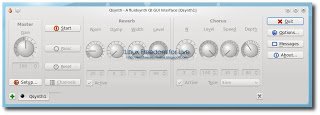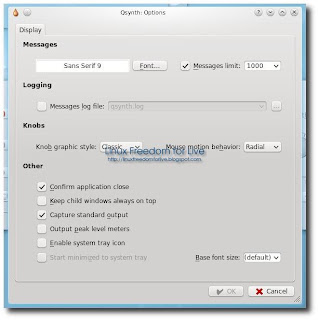QSynth è un’applicazione con GUI per fluidsynth, scritta in C++ che usa il toolkit Qt 4, che permette di prendere dei suoni di strumenti e di usarli con effetti e volumi, trasformando un file di suoni di strumenti musicali in un modulo rack emulato via software.
Ecco le novità della nuova versione 0.3.5 tratte dal sito del produttore:
* Initial widget geometry and visibility persistence logic has been slightly revised as much to avoid crash failures due to wrong main widget hidden state.
* General source tree layout and build configuration change.
* Most modal message dialog boxes (eg. critical errors) are now replaced by system tray icon bubble messages where available.
* Reverb and Chorus parameter ranges have been revised to match and comply with fluidsynth back-end (libfluidsynth).
* Fluidsynth channel info and unset program interfaces are now in use where available (libfluidsynth >= 1.1.1, EXPERIMENTAL).
* Global configuration state is now explicitly saved/committed to disk when Options dialog changes are accepted and applied.
* Output peak level meters get their long deserved gradient look.
* Automatic crash-dump reports, debugger stack-traces (gdb), back- traces, whatever, are being introduced as a brand new configure option (–enable-stacktrace) and default enabled on debug build targets (–enable-debug).
* Added Czech (cs) translation, contributed by Pavel Fric.
* The channel preset selector (Channels/Edit…) has been seriously crippled for ages, only showing the presets of the last loaded soundfont, now fixed.
* Minimum number of MIDI channels allowed on engine setup has been dropped from the old value 16 to as low as 1 (one), not that it makes a difference, as (lib)fluidsynth internals just rounds it to the nearest multiple of 16 anyway.
* Cleanup to knobs source, simplified from redundant stuff.
Per installarlo su Kubuntu basta scaricare il file .deb dal link posto sotto cliccarci sopra e confermare oppure aprire il terminale e scrivere:
sudo dpkg -i *.deb
e poi
sudo apt-get install -f
confermiamo e alla fine avremo il nostro Qsynth installato.
Per maggiori informazioni consiglio di consultare il sito del produttore accessibile direttamente dal link posto qui sotto.
home
download Ubuntu/openSUSE




